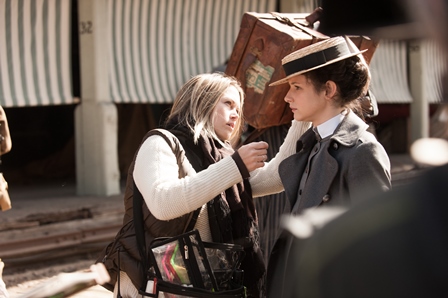Georgia Flood as Alice behind the scenes of ANZAC GIRLS. A Screentime production for ABC TV.
While writer-producer Felicity Packard was researching an ABC WW1 drama, she made a shocking discovery: More than 3,700 Australian and New Zealand nurses served overseas during the war- but only seven were awarded military medals.
The reason for that anomaly is one of the recurring themes of ANZAC Girls, a six-hour series based on real people and events at the Western Front and Gallipoli, which premieres at 8.30 pm on Sunday August 10.
Packard believes the Australian Army refused to honour the nurses because officers were opposed to young women being involved in the war.
“The Army was quite hostile to them,” Packard tells IF. This attitude is personified in the show by Colonel Thomas Fiaschi (John Waters), who, she says, “was obstructionist and critical of the nurses.” Those medals were awarded to people of “other ranks,” as nurses were not officers.
Screentime and the ABC co-produced the series, which was shot in Adelaide (whose colonial buildings resembled those in Cairo and Alexandria) and the Adelaide Hills (substituting for the Western Front). CGI was used to recreate the Gallipoli sequences, which the nurses observed from a ship about 1km offshore.
Knowing the broadcaster was looking for projects to mark the centenary of the start of the war, Packard got the idea for the drama after reading Peter Rees’ book The Other ANZACs, supplemented by diaries, letters and other historical accounts.
Screentime's Des Monaghan, Greg Haddrick and Packard pitched the concept to ABC head of fiction Carole Sklan, who responded quickly. The screenplay by Packard and Niki Aken focussed primarily on five nurses played by Georgia Flood, Antonia Prebble, Laura Brent, Anna McGahan and Caroline Craig.
Among the supporting cast are Dustin Clare, Todd Lasance, Charles Mayer, Thomas Cocquerel and Brandon McClelland as officers, and Honey Debelle as a Catholic nurse who becomes frustrated with the Army and the chauvinist attitudes.
Ken Cameron was the set-up director and directed the first three episodes set in the Middle East, and Ian Watson directed three set at the Western Front. Lisa Scott is the series producer.
There were 10 weeks of pre-production, a 10-week shot and 10 weeks of post. Apart from the ABC the financiers were Screen Australia, the SAFC and NZ on Air.
“It was a very intense shoot,” says Packard. “It tells the story of the war through the professional and personal lives of these women. I’m very proud of it and think it will really engage audiences.”
During her research Packard tracked down numerous descendants of the five protagonists, mostly grandchildren plus one great niece and the 90-year-old daughter of one, who visited the set. “They were incredibly supportive,” she says.
All3 Media sold the US and Canadian rights to Acorn Media and to broadcasters in Brazil and Sweden.


